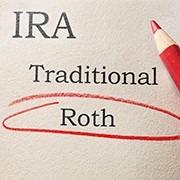When you convert a traditional IRA into a Roth IRA and then reverse the transaction by switching the account back to its original status, the reversal is called a recharacterization.
Similarly, making an annual contribution to one type of IRA and then reversing it to another type
is also a recharacterization. But for Roth conversions done in 2018 and beyond, the Tax Cuts and Jobs Act (TCJA) eliminates your ability to recharacterize a converted amount back to traditional
IRA status. This is really the only bit of bad news for Roth IRAs in the TCJA, but it eliminates one
of the major advantages of Roth accounts.
Unlike most of the TCJA changes that affect individual taxpayers, this one is permanent. But the
tax law still allows some IRA recharacterizations. Here’s what you need to know about which ones you can and can’t do under the TCJA.
Still a Good Investment
Roth IRAs still make good sense for many individuals. In a nutshell, anyone who expects to be in the same or higher tax bracket during retirement should consider contributing to a Roth IRA. That’s because qualified Roth withdrawals taken after age 59½ are federal-income-tax-free and usually state-income-tax-free. So, you can eventually withdraw all the income and gains that accumulate in your Roth IRA without paying federal taxes.
Also, if you leave your Roth IRA to a beneficiary, he or she can take tax-free qualified withdrawals if you’ve had at least one Roth IRA open for over five years before withdrawals are taken from the inherited account. Nice! In contrast, a beneficiary will generally owe income tax on all or part of any withdrawals taken from an inherited traditional IRA.
Conversions in 2017 Can Still Be Reversed but Mind the Deadline
While the TCJA prohibits reversals of Roth conversions that are done in 2018 and beyond, guidance posted on the IRS website confirms that you can still recharacterize a 2017 conversion, if you get it done by October 15, 2018. That is the same as the extended deadline for filing your 2017 Form 1040 if you filed an extension, but it applies for 2017 Roth conversion recharacterization purposes whether or not you actually extended your 2017 return. You accomplish the switch by turning in the appropriate form to your IRA trustee or custodian.
Example: In 2017, you converted two traditional IRAs, Account X and Account Y, into two Roth accounts. Account X has gone up in value since the conversion date. But Account Y has taken a beating, because it was loaded with stocks that took big hits during a market downturn. Account Y is now worth significantly less than it was on the conversion date. If you don’t reverse the Account Y conversion, you’ll wind up paying income tax on value that has now disappeared.
Why? Because the balance of Account Y on the conversion date is treated as a taxable traditional IRA distribution to you followed by a contribution to new Roth IRA Account Y. Thankfully, you have until October 15, 2018 to recharacterize Account Y back to traditional IRA status. The recharacterization has the effect of reversing the 2017 conversion of Account Y into Roth IRA status. After the recharacterization, it’s as if the ill-fated Account Y conversion never happened. So, you won’t owe any 2017 income tax on the now-reversed conversion of Account Y. No tax harm done! You can leave Account X in Roth IRA status.
Tax Return Implications
If you extended the filing deadline for your 2017 Form 1040 to October 15, 2018, and haven’t yet filed your return, you reflect the reversal of the 2017 Roth conversion by simply not including on the return the taxable income that would have been triggered by the conversion. If you’ve already filed your 2017 Form 1040, you’ll need to file an amended 2017 return to delete the conversion income and claim a refund for the related tax liability. Your tax advisor can help with that.
Reconverting after a Reversal
 After you reverse a Roth account back to traditional IRA status, you can still reconvert the account back to Roth status. This time around, however, the conversion tax hit will be lower, because the account balance is lower and your tax rate is probably lower thanks to the TCJA reductions.
After you reverse a Roth account back to traditional IRA status, you can still reconvert the account back to Roth status. This time around, however, the conversion tax hit will be lower, because the account balance is lower and your tax rate is probably lower thanks to the TCJA reductions.
However, there’s a timing restriction on the reconversion privilege. After you recharacterize an account back to traditional IRA status, you cannot reconvert it to Roth status until 30 days after the recharacterization date.
Other Recharacterizations Are Still Allowed
As explained at the beginning of this article, an IRA recharacterization is any transaction that allows you to treat a contribution to a Roth IRA or to a traditional IRA as having been made to the other type of IRA.
And, as we explained, you cannot recharacterize Roth conversions done in 2018 and beyond back to traditional IRA status.
But for 2018 and beyond, you can still recharacterize a regular annual contribution to one type of IRA into a regular annual contribution to the other type of IRA. In effect, you are treated as having contributed to the second type of IRA and the contribution to the first type of IRA is simply ignored.
For 2018, the total of your regular annual contributions to IRAs (traditional and Roth) is limited to the lesser of:
1. $5,500 ($6,500 if you will be age 50 or older as of December 31, 2018), or
2. Your earned income for the year.
Paperwork and Deadlines
To recharacterize a contribution, turn in the appropriate form to your IRA trustee or custodian. To reverse a 2017 contribution, you must act by October 15, 2018. To reverse a 2018 contribution, you must act by October 15, 2019.
Example: For 2018, you make a regular annual contribution of $5,500 to a traditional IRA. You later realize that your 2018 income is too high to deduct the contribution. But your income doesn’t prevent you from making a 2018 regular annual contribution to a Roth IRA. You can recharacterize the traditional IRA contribution into a Roth IRA contribution before the October 15, 2019, deadline.
Conclusion
Although the TCJA eliminates the ability to recharacterize, or reverse, Roth IRA conversion transactions done in 2018 and beyond, you can still reverse a 2017 Roth conversion if you get it done by October 15, 2018. For 2018 and beyond, other types of recharacterizations are still allowed. If you have questions about these changes or want more information, contact your PDR tax advisor.
©2018






